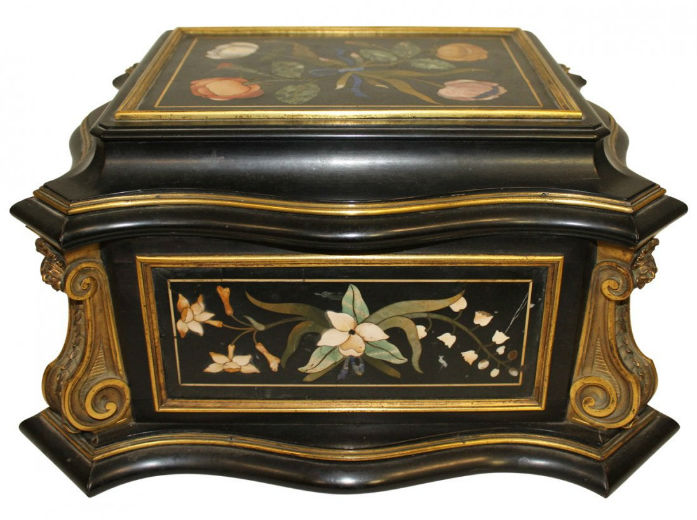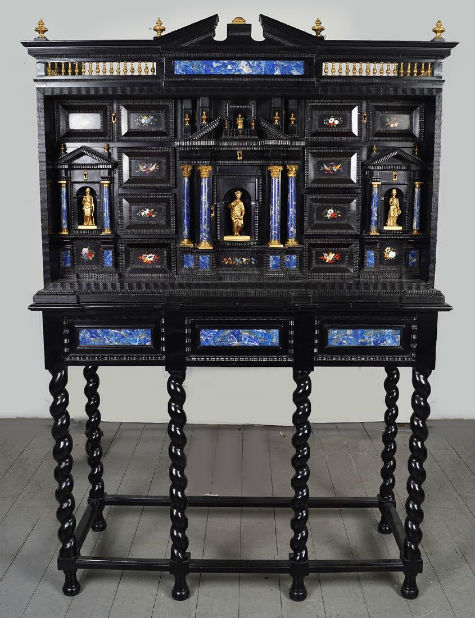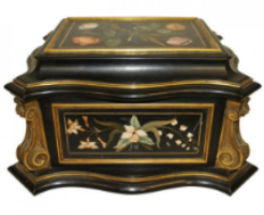
NEW YORK – Pietra dura is one of the most elegant inlay techniques employed in crafting furniture, especially tables and wooden objects. Translated from Italian, “pietra dura” means hard stone and speaks to the durability of the materials as well as their long-lasting beauty. One might describe this art form as painting with stones and the skill of the artist is matched only by the beauty of the materials they use.
Artists often use colorful and highly polished precious and semiprecious stones like quartz, mother-of-pearl, malachite, lapis lazuli, agate, porphyry, chalcedony and jasper that are sliced thin to painstakingly create beautiful inlaid designs, marrying art and nature to create an endless variety of examples. Each thin piece of stone would be cut into a specific shape and the stones would fit together like a jigsaw puzzle to create a design.

For centuries, pietra dura has been a thriving business and artistic practice. Many of the best examples were made by European craftsmen, especially in Italy, where Giovanni Montelatici (1864-1930) was an Italian Florentine artist whose work in this field is globally collected today by buyers looking for sophisticated pieces. Many more pieces were made by artists whose identities are unknown today but that does not lessen the quality of their work.
An early – and important – proponent was the Grand Duke Ferdinando I de’ Medici of the Italian court, who founded a workshop in 1588 to specialize in semiprecious mosaics and inlay work. This institution produced fine work for two centuries, making the city of Florence a hotbed for pietra dura and inspiring other areas of manufacture, and it ultimately became the museum known as Opificio delle Pietre Dure, which many visitors to Florence visit.

The V&A Museum in London houses some choice examples, including this circa 1620 table from the Grand Ducal workshops, which produced goods in this style such as tabletops, caskets and cabinet pieces. During the Renaissance in Italy, exceptionally large table and cabinet doors and drawer fronts were decorated in the pietra dura style. Small items were often gifted to visiting diplomats. “The expense and exoticism of its raw materials, combined with the artistic and technical skill needed to create these ‘stone paintings,’ ensured the desirability of pietra dura work to collectors of the highest status,” according to commentary on the museum’s website.
While pietra dura is commonly associated with Italy, some claim its origins are in India and indeed one of the finest – and largest – examples of pietra dura work is in India in the form of the Taj Mahal, commissioned by Mughal emperor Shah Jahan, who requested the tomb be bedecked in precious stones inlaid in white marble. The mausoleum was built in memory of his wife in the 1600s. Indian examples of pietra dura tabletops are quite collectible, often featuring a marble border and hexagonal in shape.

Many fine museums around the world have sublime examples of pietra dura in their collections. An ornate pietra dura tabletop in New York’s Metropolitan Museum of Art is striking for its fine geometric design and central alabaster oval which is surrounded by marble roundels of marble. This kind of work was more common in Rome, circa 1600, instead of Florence. “The severity of the inner decoration seems to translate jewelry designs from contemporary pattern books while the border of wild animals, blossoms emitting seeds like strings of pearls, leafy scrollwork and floral sprays includes motifs derived from ancient Roman mosaics,” according to commentary on the museum’s website.
Pietra dura furniture and objects are also highly collectible with private buyers. The top price on LiveAuctioneers’ price database is an important pietra dura center table that sold at Kennedy’s Auction Service for $180,000 in June 2011. In recent years, an Italian ebony piece of furniture decorated with hard stone (pietra dura) panels depicting flower, fruit and bird motifs attained $61,838 in April 2015 at Gregory’s Casa d’Aste sas di Samarro Francesca while a 19th century pietra dura casket, 15 by 8½ by 14¼ inches, made $20,000 in November 2016 at Dutch Auction Sales.

Pietra dura tabletops have long been desirable and many examples have marble bases. Case furniture and “smalls,” such as wooden boxes, bowls, cameos and plaques, are also well suited as canvases for this historic art form. Typical design motifs find inspiration from the natural world with vines, fruit, flowers, birds being prolific subjects, but geometric patterns were also prevalent. As modernism dawned, however, tastes changed and this genre fell out of favor. Today, demand is again high for antique examples.



